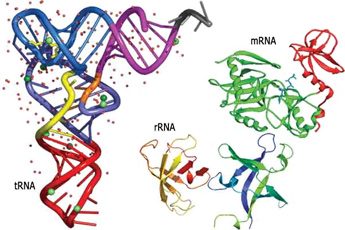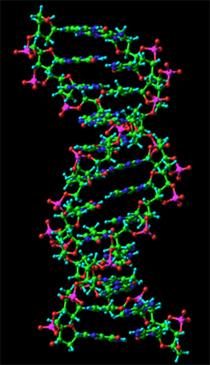 When DNA was first discovered six decades ago, the world was fascinated by the simple beauty of the double-helix; 23 pairs of chromosomes precisely positioned in an elegant spiral. Even more fascinating was the realization that the entire genetic code for a unique human being was contained in this microscopic structure; an infinitesimal blueprint for life.
When DNA was first discovered six decades ago, the world was fascinated by the simple beauty of the double-helix; 23 pairs of chromosomes precisely positioned in an elegant spiral. Even more fascinating was the realization that the entire genetic code for a unique human being was contained in this microscopic structure; an infinitesimal blueprint for life.
What we’ve discovered over time is that the simple cell has never really been “simple” – it’s unbelievably complex. And as scientists have continued their research, deciphering the code (mapping the human genome), peering ever closer, the original double-helix structure has necessarily grown more and more complicated.

Each human body is made up of sixty trillion cells. Yet a strand of DNA is so extremely thin that each one of those cells contains a piece 5 to 6 feet long. And tiny as it is, the information coded within that tightly coiled strand is so intricate and specific that it describes the genetic make-up of exactly one of the more than 107 billon people who have ever lived on earth.
Each one of our individual cells contains fifty billion atoms, arranged into more than one hundred different proteins, packed full of genetic information; DNA, as well as RNA (ribonucleic acid) which governs the cells’s nutrition, repair and replication.
The “simple” living cell contains an amazingly complex maze of tiny tubes, miniature chemical factories, transportation and communication systems transmitting millions of precise instructions between DNA and RNA – all synchronized in perfect harmony. (The inspiration for the rapidly growing field of nanotechnology.)
~~~~~~~~~~~~~~~
“The chance that higher life forms might have emerged in this way (by coincidence) is comparable with the chance that a tornado sweeping through a junk-yard might assemble a Boeing 747 from the materials therein.”
~ Sir Fred Hoyle
~~~~~~~~~~~~~~~
Unavoidably, the more micro-biologists learn about the structure of the cell and its functions, the more detailed and intricate the DNA model has become.
They’ve now identified hundreds of distinct proteins, different types of RNA, depending upon it’s function within the cell; tRNA, rRNA, mRNA…
If they discover much more complexity, they’ll run out of ways to explain and represent it!

So here’s the thing – given all the unbelievably complicated information packed into each nucleus, considering the purposeful activities occurring at a cellular level, how is it even conceivable that something so complex we humans can barely comprehend it, could have evolved??
The more scientists learn about these amazing building blocks of life, the less chance it’s even remotely possible that these tiny cells, and everything in them, could have self-assembled.
~~~~~~~~~~~~~~~~~~~~~~~~~
More than 25 years ago, botanist and biologist Dr. George Howe, calculated the probability that the complex genetic information encoded in DNA could have been produced by random mutation;
The chance that useful DNA molecules would develop without a Designer are approximately zero.
… let me conclude by asking which came first – the DNA (which is essential for synthesis of proteins) or the protein enzyme (DNA-polymerase) without which DNA synthesis is nil? … there is virtually no chance that chemical “letters” would spontaneously produce coherent DNA and protein “words.”
Since Howe wrote that, research has of course only revealed more complexity at the cellular level, so now the odds of evolution must be… less than zero!!
Only a committed Darwiniac would ignore the evidence of intelligent design clearly present in DNA. It’s hard to imagine even Charlie himself would believe that if – after each new discovery of complexity – we just keep tacking a few billion more years on to the universal timeline, somehow the genetic code (which contains 5 billion “letters”), and its ability to repair and replicate itself, would have had enough time to s l.. o.. o..w l y come into being (from nothing!). Yet that’s exactly what evolutionary biologists have been doing for decades; assuming an ever-older earth.
Lately, they must have realized that a gazillion-year old universe was a bit much, so they’re getting more creative with their theories. For instance, what if we’re just a tiny speck in a massive “multiverse…?”
~~~~~~~~~~~~~~~~~~~~~
From micro-biology on one end of the spectrum, to the vastness of the cosmos on the other, every organism, process and law of nature bears witness – as Discover Magazine pointed out – to an extraordinary fact about the universe:
Its basic properties are uncannily suited for life. Tweak the laws of physics in just about any way and — in this universe, anyway — life as we know it would not exist.
Physicists don’t like coincidences. They like even less the notion that life is somehow central to the universe, and yet recent discoveries are forcing them to confront that very idea. Life, it seems, is not an incidental component of the universe, burped up out of a random chemical brew on a lonely planet to endure for a few fleeting ticks of the cosmic clock. In some strange sense, it appears that we are not adapted to the universe; the universe is adapted to us.
But scientists just can’t let a Divine foot in the door, and;
Short of invoking a benevolent creator, many physicists see only one possible explanation: Our universe may be but one of perhaps infinitely many universes in an inconceivably vast multiverse. 😯 Most of those universes are barren, but some, like ours, have conditions suitable for life.
“Multiverse” is just the latest conjecture to be proposed to keep Darwin’s theory of evolution afloat.
Rather than go where the DNA evidence takes them (to a DESIGNER), some scientists just refuse to evolve beyond their own (Darwinian) assumptions. They simply posit theories that become more and more implausible.
There are still evolutionists so committed to their theories (and atheist worldview) they’ll never accept the truth until they discover a miniature manufacturer’s label inside the cell proclaiming “designed by God.”
~~~~~~~~~~~~~~~~~~~~~
Related:
Now Evolution Must Have Evolved Different Functions Simultaneously in the Same Protein ~
Simply put, evolution either must have evolved two independent designs simultaneously in the same protein, or it must have been a two-fer, evolving the one design and getting the second for free. Either way the evidence does not bode well for evolution.






Pingback: Evolution? Where’s the evidence…? | Designs on the Truth
I applaud to those who take time to defend Divine Design. Keep up this loving work for your recompense will be a crown of glory. I hope in my life to get to see scientists fall down on their knees to acknowledge the Creator.
Thanks very much for the words of encouragement. God bless!
Pingback: The Master Coder | Designs on the Truth